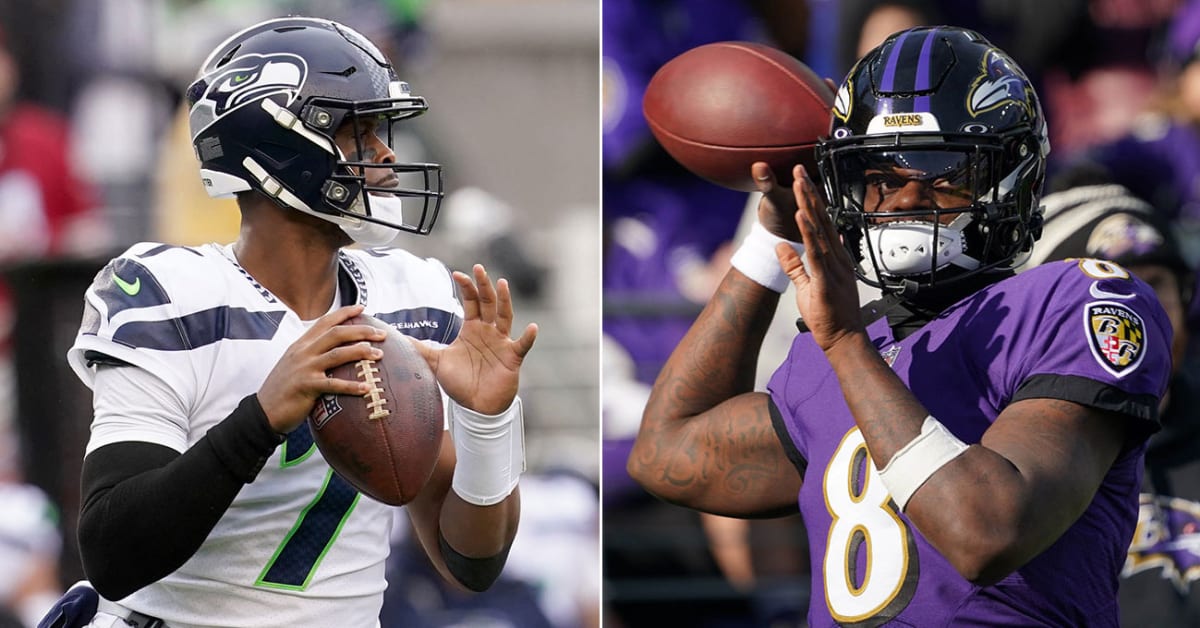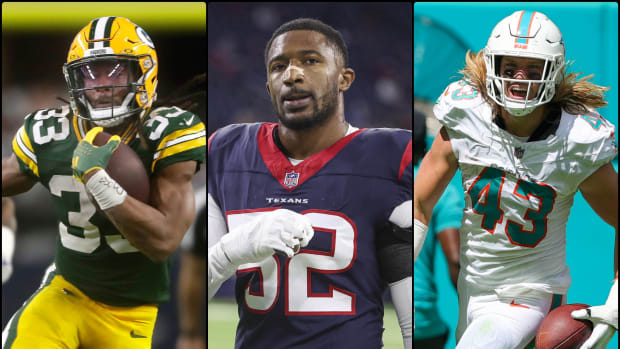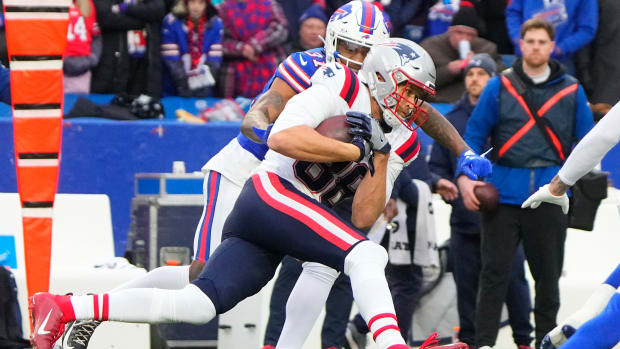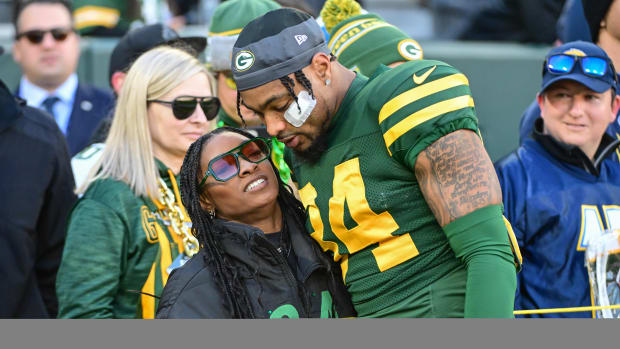Why the Franchise Tag Still Exists and How It Impacts Free Agency
We are entering that time of the year on the NFL calendar when it’s my time to shine: as the game is on hold for several months and the business of the NFL takes center stage. Not to worry, though, I’ll get you through it.
Even before the start of the new league year next week and the resolution of the Aaron Rodgers drama, there has been much NFL business and so many questions to answer. Here are my thoughts on some of the top business of football stories.

The franchise tag impacts more players than most people realize, thanks to a trickle-down effect.
Cary Edmondson/USA TODAY Sports (Smith); Mitch Stringer/USA TODAY Sports (Jackson)
Why does the franchise tag continue to persist?
After playing out his undervalued rookie contract and (ostensibly) becoming a free agent this week, Lamar Jackson faced the inevitable. Of course he never even neared becoming a true free agent, as the Ravens applied the nonexclusive franchise tag and kept his rights for a relatively minor cap and cash charge of $32 million. Sure, Jackson could receive offers from teams willing to give up two first-round picks, but let’s be clear: That is not the same thing as being a free agent. I wrote about Lamar’s inability to “bet on himself” or to leverage the Deshaun Watson precedent back in January.
And the same is true for Saquon Barkley, Tony Pollard, Josh Jacobs, Evan Engram and Daron Payne; the tag gives teams the ability to take their top free agent off the market, forcing them to negotiate with only one team instead of 32.
Removal of the tag has never seemed to be a priority for the NFLPA in CBA negotiations. When I asked about it years ago, I was told that since the tag affects only a handful of players each year, it was not going to be a priority issue. But here’s the thing: The tag doesn’t just affect a handful of players; it affects hundreds.
The tag is used in countless negotiations where it is never applied; it is a leverage play by the teams letting the agents know the tag is always there to be weaponized. In my 10 years negotiating team contracts, I mentioned the tag dozens of times but never actually used it. And the tag restricts earnings of the top players at the position, then trickling down to affect all players under the top.
Simply, the tag is a powerful management weapon to restrict movement and compensation for the best free agents (who are not really free agents at all). And with the next CBA negotiation not happening for almost a decade, the tag is here to stay for the foreseeable future.
Watch the NFL with fuboTV. Start your free trial today.
What will Aaron Rodgers do?
My sense all along is that it has been time for a pivot in Green Bay, almost exactly like there was 15 years ago.
For me, déjà vu is strong right now. I remember when I worked for the Packers we had a first-round quarterback (Rodgers) who apprenticed behind a Hall of Fame quarterback (Brett Favre) for three long years before we handed the apprentice the keys to the franchise. Now, the Packers have a first-round quarterback (Jordan Love) who apprenticed behind a Hall of Fame quarterback (Rodgers) for three long years before, it seems, they want to hand the apprentice the keys to the franchise.
I have sensed Rodgers’s decision-making would have been awkward were he to decide to return to the Packers, as they have appeared ready to move to Love. Of course, they groveled to Rodgers, emotionally and financially, for the past few years, and will pay the price with a staggering $40 million dead-money cap charge when he goes elsewhere.
As of this writing, the Jets are wooing the Packers’ Hall of Fame quarterback toward a potential trade (and again, it’s so familiar to 15 years ago). The symmetry is uncanny.
What do you think of Derek Carr’s contract with the Saints?
Carr’s contractual situation over the past year proves what I always say: Even for the best players, NFL contracts are more “suggestions” than binding contracts. Carr’s four-year extension with the Raiders last summer lasted six months, as that contract was terminated in February. Now Carr has signed another four-year deal, this time with the Saints, and hopefully—for his sake—this one will last a lot more than half a year.
Financially, Carr is somewhat better off than he would have been had the Raiders not soured on him. He now has $60 million guaranteed over two years, compared to his previously scheduled $41 million guaranteed over one year, with another $10 million “functionally” guaranteed (assuming the Saints don’t cut him after one year as the Raiders did). But as to reports of a four-year, $150 million deal? Well, that’s a nice headline, but it’s two years, $60 million; and probably another $10 million, but we’ll see.
When I asked his agent why they picked the Saints over other interested teams like the Jets and Panthers, Carr was appreciative they were the first team to show interest after his release and maintained that interest throughout. As for the Saints, their post–Drew Brees quarterback experiments continue as they once again kick the cap can down the road.
What do you think of Geno Smith’s contract with the Seahawks?
This is one of the greatest stories not just in football, but in all of sports. Smith was a career backup, moving from team to team on one-year deals with backup money. He earned $17 million over the last 10 seasons, with $3.5 million of it coming in incentives from the Seahawks this past season. Guys like him never seem to ascend to a top-level veteran quarterback contract; it is hard to think of one (perhaps Ryan Fitzpatrick). Now Smith has been rewarded for his remarkable 2022 season.
As with the Carr deal, the reporting was fed through the agent with unrealistic numbers. What was reported as three years, $105 million is really two years, $40 million with another $10 million highly probable (but, as we often see in the NFL, you never know). And the Seahawks will likely draft his replacement next month.
Whether $20 million a year or $35 million a year, Geno Smith has overcome massive odds to reach this financial plateau. Again, this is one of the best stories in sports.
What do you think of Daniel Jones’s contract with the Giants?
I am a bit partial here. During the end of 2018 and the beginning of ’19, I got to know Jones and his family as part of their agent selection process (long story for another time). I found Daniel to be wonderfully humble and respectful.
The Giants could have had Jones under contract for 2023 had they exercised a fifth-year option price of barely $20 million before last season, but they did not exercise it. Jones was then able to truly bet on himself, and he won. I haven’t seen the particulars, but reports of $82 million over the next two years are impressive: $12 million more than Derek Carr will receive, and Carr was a free agent.
As for the full deal of $160 million over four years, that is identical to what Dak Prescott received a couple of years ago and, guess what: Jones recently switched agents to Athletes First, who are—you guessed it—Prescott’s agents.
Could you (briefly) explain the difference between cash and cap?
It’s an important question, as many focus on the wrong thing (cap) and not the important thing (cash). Think of it this way: Cap is just accounting. It’s just bookkeeping, figuring out where to allocate charges. Cash is hard, cold money, the important thing.
Here’s a reality in the NFL: Fans and media sometimes pay more attention to cap than even the teams do. Some teams have conservative cap management (as I tried to do in Green Bay), trying to match cap and cash as much as possible toward having flexibility in the future. Other teams are less risk-averse, and have no problem pushing off cap charges into the future despite the negative consequences later on. But the point is: Cap is the team’s concern, not really that of the fans, media or—especially—agents.
When agents would tell me they could “work with me on the cap,” I would politely—or not so politely—tell them, “The cap is our problem; you worry about your client.” And when looking at contracts, whether as an agent or a team executive, I never evaluated the deals based on cap. I evaluated them based only on cash: how much in the first year, how much over three years, etc.
That’s what really matters: How much money is the player receiving? I tell fans and media the same: Focus on the cash, and let the teams worry about how they do their bookkeeping. And don’t be fooled by the team or owner narratives about not having cap room to do X or Y; the issue is cash, not cap, and they all have enough of that.

Carter was viewed as a likely top-five pick heading into the combine.
Mark J. Rebilas/USA TODAY Sports
Will Jalen Carter’s legal troubles affect his draft status?
Carter had more involvement than previously known in a fatal car crash that left a Georgia teammate and staffer dead on the night of their victory parade after the national championship. First, let’s get this out of the way: Were he a down-the-line prospect he would be off most draft boards. But as I say: greater talent = greater tolerance.
The timing is important here. What seemed like a big deal in the beginning of March will have faded from view by the end of April. And Carter will face no discipline from the NFL: pre-employment conduct is not subject to NFL review. Thus to answer the question above, no. Carter will be drafted where he was projected to be drafted before this news.
Will the NFLPA survey of the teams have any lasting impact?
I am not sure what the intent of the survey was, but the results garnered a lot of attention, including from this writer. The Jaguars had a rat infestation? Yuck. The Cardinals made players pay for their meals at the facility? I was with the Packers when we started serving meals at the facility; we strongly encouraged, if not mandated, players to eat our food rather than fend for themselves (especially the linemen) as we prepared it with guidance from our conditioning staff. I cannot imagine actually making players pay, as it benefits the team as much as the players.
One team ranking also really stuck out among the group: The Super Bowl champion Chiefs had a very unfavorable rating, 29th out of the 32 teams, and their training staff was seen as especially unfavorable. Players feel pressure to play through injuries. As for the team at the bottom of the rankings, they were “on brand”: the Commanders.
As to the lasting impact from this survey, well, players all talk among themselves, so it’s likely they know these things already. But for the handful of players who will have options as to where they play—free agents with multiple suitors—these things do matter and may be used for tie-breaking purposes.
Much more to come in this NFL offseason, the longest offseason in professional sports. Settle in, and know this: The business of the NFL always wins.





































